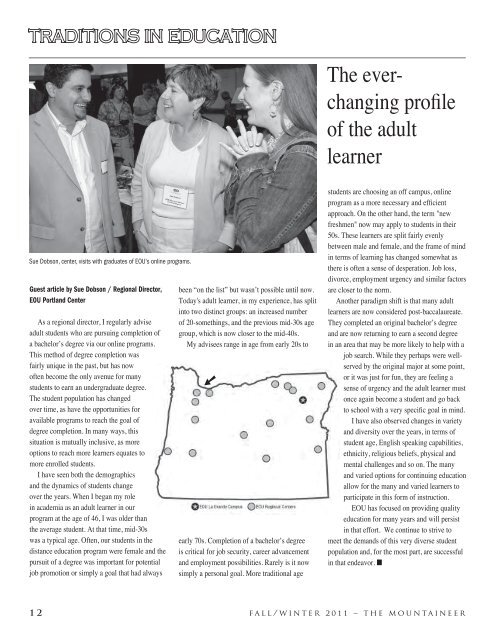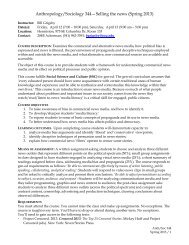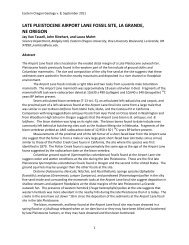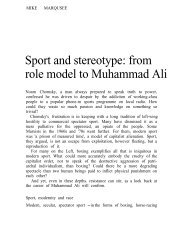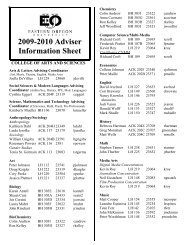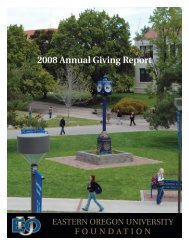traditions in education - Eastern Oregon University
traditions in education - Eastern Oregon University
traditions in education - Eastern Oregon University
You also want an ePaper? Increase the reach of your titles
YUMPU automatically turns print PDFs into web optimized ePapers that Google loves.
<strong>traditions</strong> <strong>in</strong> <strong>education</strong><br />
Sue Dobson, center, visits with graduates of EOU's onl<strong>in</strong>e programs.<br />
Guest article by Sue Dobson / Regional Director,<br />
EOU Portland Center<br />
As a regional director, I regularly advise<br />
adult students who are pursu<strong>in</strong>g completion of<br />
a bachelor’s degree via our onl<strong>in</strong>e programs.<br />
This method of degree completion was<br />
fairly unique <strong>in</strong> the past, but has now<br />
often become the only avenue for many<br />
students to earn an undergraduate degree.<br />
The student population has changed<br />
over time, as have the opportunities for<br />
available programs to reach the goal of<br />
degree completion. In many ways, this<br />
situation is mutually <strong>in</strong>clusive, as more<br />
options to reach more learners equates to<br />
more enrolled students.<br />
I have seen both the demographics<br />
and the dynamics of students change<br />
over the years. When I began my role<br />
<strong>in</strong> academia as an adult learner <strong>in</strong> our<br />
program at the age of 46, I was older than<br />
the average student. At that time, mid-30s<br />
was a typical age. Often, our students <strong>in</strong> the<br />
distance <strong>education</strong> program were female and the<br />
pursuit of a degree was important for potential<br />
job promotion or simply a goal that had always<br />
been “on the list” but wasn’t possible until now.<br />
Today's adult learner, <strong>in</strong> my experience, has split<br />
<strong>in</strong>to two dist<strong>in</strong>ct groups: an <strong>in</strong>creased number<br />
of 20-someth<strong>in</strong>gs, and the previous mid-30s age<br />
group, which is now closer to the mid-40s.<br />
My advisees range <strong>in</strong> age from early 20s to<br />
➘<br />
early 70s. Completion of a bachelor’s degree<br />
is critical for job security, career advancement<br />
and employment possibilities. Rarely is it now<br />
simply a personal goal. More traditional age<br />
The everchang<strong>in</strong>g<br />
profile<br />
of the adult<br />
learner<br />
students are choos<strong>in</strong>g an off campus, onl<strong>in</strong>e<br />
program as a more necessary and efficient<br />
approach. On the other hand, the term "new<br />
freshmen" now may apply to students <strong>in</strong> their<br />
50s. These learners are split fairly evenly<br />
between male and female, and the frame of m<strong>in</strong>d<br />
<strong>in</strong> terms of learn<strong>in</strong>g has changed somewhat as<br />
there is often a sense of desperation. Job loss,<br />
divorce, employment urgency and similar factors<br />
are closer to the norm.<br />
Another paradigm shift is that many adult<br />
learners are now considered post-baccalaureate.<br />
They completed an orig<strong>in</strong>al bachelor’s degree<br />
and are now return<strong>in</strong>g to earn a second degree<br />
<strong>in</strong> an area that may be more likely to help with a<br />
job search. While they perhaps were wellserved<br />
by the orig<strong>in</strong>al major at some po<strong>in</strong>t,<br />
or it was just for fun, they are feel<strong>in</strong>g a<br />
sense of urgency and the adult learner must<br />
once aga<strong>in</strong> become a student and go back<br />
to school with a very specific goal <strong>in</strong> m<strong>in</strong>d.<br />
I have also observed changes <strong>in</strong> variety<br />
and diversity over the years, <strong>in</strong> terms of<br />
student age, English speak<strong>in</strong>g capabilities,<br />
ethnicity, religious beliefs, physical and<br />
mental challenges and so on. The many<br />
and varied options for cont<strong>in</strong>u<strong>in</strong>g <strong>education</strong><br />
allow for the many and varied learners to<br />
participate <strong>in</strong> this form of <strong>in</strong>struction.<br />
EOU has focused on provid<strong>in</strong>g quality<br />
<strong>education</strong> for many years and will persist<br />
<strong>in</strong> that effort. We cont<strong>in</strong>ue to strive to<br />
meet the demands of this very diverse student<br />
population and, for the most part, are successful<br />
<strong>in</strong> that endeavor. ■<br />
12 fall/w<strong>in</strong>ter 2011 – the mounta<strong>in</strong>eer


